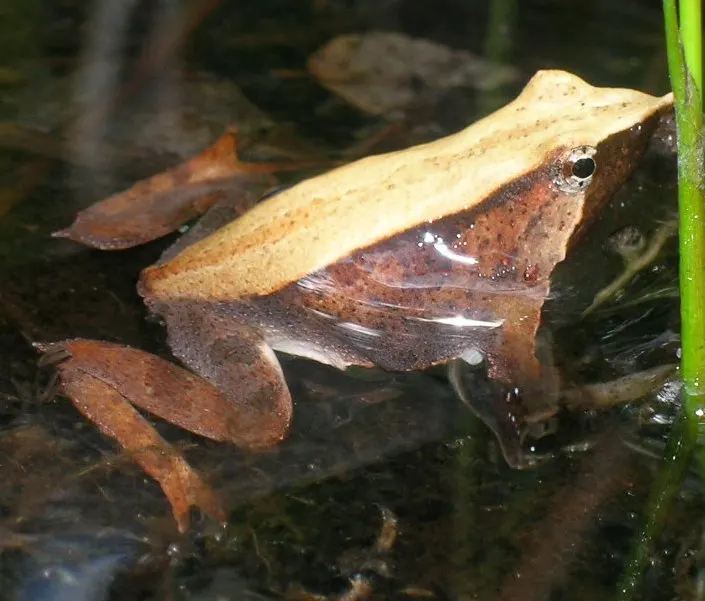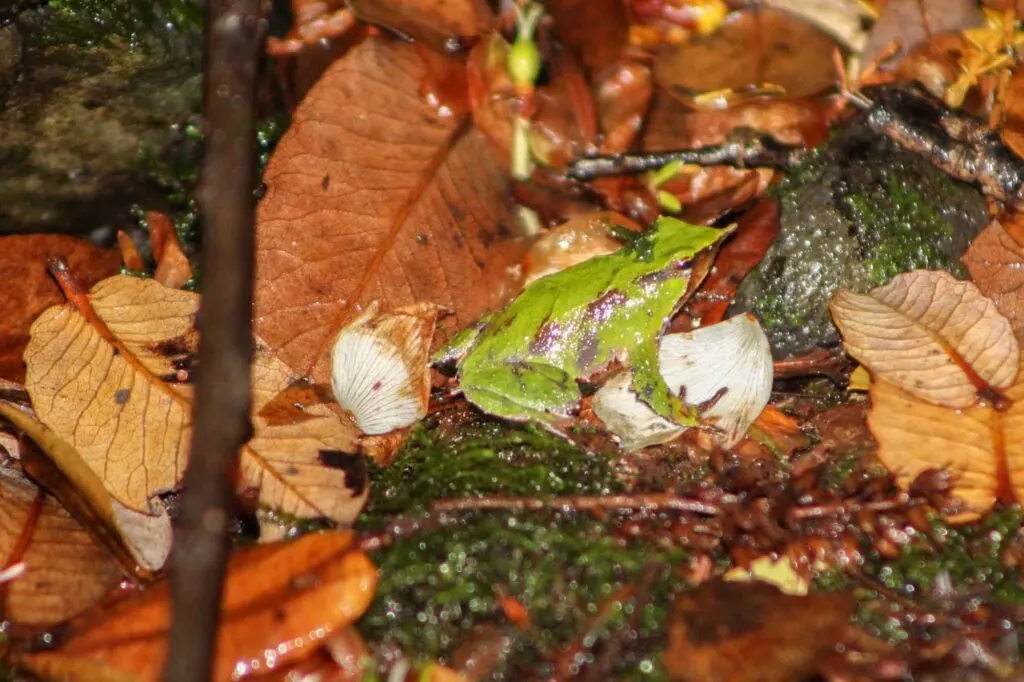Small and adaptable, Darwin’s frog is a carnivorous species that is both unique and incredibly smart. Still, this tiny amphibian is nearly extinct.

Darwin’s Frog
Rhinoderma darwinii
Darwin’s Frog Scientific Classification
- Kingdom: Animalia
- Phylum: Chordata
- Class: Amphibia
- Order: Anura
- Family: Rhinodermatidae
- Genus: Rhinoderma
- Species: Rhinoderma darwinii
Darwin’s Frog Appearance

- Lifespan: 10-15 years
- Length: 1-1.2 inches
- Weight: 0.5 ounces
- Top speed: 5 mph
Darwin’s frogs are notable for their unique look and size. With a length of only 1.2 inches and weight measuring 0.2 ounces, they are pretty small animals.
These carnivorous frogs have a round body, long fingers, and thin legs well suited for hopping.
The triangular shape of the animals’ head is due mainly to its pointy nasal extension, which has a fleshy horn-like tip. Their small, sharp eyes and their nostrils are located on top of its head.
Darwin’s frogs’ front feet are not webbed, unlike many other frogs, and only a few toes on hind feet are webbed. This is because the animal spends most of its time on the ground.
The R. Darwinii, or Darwin’s frog, moves pretty quickly and can cover up to 5 miles in an hour. As these amphibians adapt their color to their environment for camouflage, coloration varies depending on location, and no two individuals appear the same.
In general, the rhinoderma darwiniis are brown or green on the upper side, while their underside could be black or white, with yellow or orange spots depending on the individual. Some individuals may have white limbs and markings on their backs.
Females do not carry a distensible vocal sac, are generally brown, and can be found in areas matching that color.
At the same time, males vary more in color and substrate and possess a vocal sac that swells during incubation. Darwin’s frog skin is moist and mostly smooth, with sparse warts.
Did you know? Darwin’s Frogs camouflage themselves as dead leaves!
Darwin’s Frog Range & Habitat
Although Darwin’s frogs can still be found across a large part of its historical range, the remaining frog populations are small and severely fragmented.
Darwin’s frogs live primarily in the native forests of Argentina and Chile. Their habitats are usually close to flowing water.
While they’ve been observed residing at high altitudes of up to 3,600 feet, these frogs generally favor swamps, bogs, tree hollows, forest floors, and mossy areas as living spaces.
Places with low foliage are perfect for Darwin’s frogs, as the soil in these areas conserves water better, thus keeping the temperature down.
These frogs can also escape predators more easily in such sites by using their camouflage. Darwin’s frogs seek out mossy areas and fallen logs where they can rest or sleep in the daytime.
Distribution
- Continents: South America
- Countries: Argentina and Chile
Habitats
Forest | Wetlands (inland)
Darwin’s Frog Behavior and Lifestyle
Darwin’s frogs are diurnal creatures, spending the night sleeping and getting active in the daytime.
These frogs spend significant portions of their day basking in the sunlight. They are solitary animals, only associating with other individuals when it’s time to mate.
When predators are near, these carnivorous frogs pretend to be dead by employing their camouflage. They lie motionless on the ground or jump into water and float, changing their color to appear like a dried leaf.
Another defensive strategy Darwin’s frogs use is flipping over and exposing their patterned lower surface, which usually matches surrounding debris. They stay completely still in this position until the predator passes by, possibly mistaking the tiny frog for a twig or leaf.
Darwin’s Frog Diet
Darwin’s frogs are carnivorous animals. They feed on insects, worms, spiders, snails, and other invertebrates.
Darwin’s frog’s hunting style is designed to catch prey and, at the same time, avoid predators.
When hunting, they usually remain motionless, lying in ambush for the prey.
Once the unsuspecting prey is within close range, the frog leaps forward, sticking out its long tongue, and pulls it back in, capturing the prey in a rapid movement.
This way of hunting helps the animal escape predators, as it blends completely with its surroundings while waiting for prey.
Darwin’s Frog Reproduction and Mating
Darwin’s frog breeding habits, unique among amphibious animals, are perhaps the most famous thing about this species.
While mating usually takes place between November and March, Darwin’s frogs can mate all year round.
The male, using its big vocal sac, makes sing-song bell-like sounds to attract mates. As the females prefer to lay eggs on damp soil with scattered leaves, the male leads his mate to such an area for mating. The female may lay up to 40 eggs after the act.
After laying her eggs, the female leaves. The male fertilizes the eggs and guards them for 3 or 4 weeks.
When the embryo begins to squirm, it means the eggs are close to hatching, which is when the male ingests the eggs and deposits them in his vocal pouch, where they hatch into tadpoles after three days.
The frog’s internal organs shift to make space for the young, and the vocal sac becomes enlarged, acting as a makeshift nursery.
The tadpoles develop for 6 to 7 weeks, surviving on their egg yolk and nutritious secretions produced in the sac.
By the end of this period, the froglets move into the adult frog’s mouth, having grown to half an inch and developed limbs.
The father then locates a water source and expels the young through its mouth in a cycle of convulsions.
Up to 19 froglets may emerge during the process, most of them immediately swimming away. Darwin’s frogs can live up to 15 years in the wild.
Darwin’s Frog Conservation Status
Endangered[1]
Darwin’s Frog Predators and Threats
Rodents, birds, and snakes are some of Darwin’s frog’s major predators in the wild.
For predators, these carnivorous frogs are relatively easy to hunt due to their smallness. The biggest threat to Darwin’s frog’s existence is, however, not its animal predators.
The population size is quickly declining due to the banishing of Chile’s temperate forests, diseases, overall habitat loss, climate change, ultraviolet radiation, and human activity.
Some of the major threats to Darwin’s Frogs are the fungus chytrid, which causes an infectious disease called amphibian chytridiomycosis.
All these factors are responsible for the decline in amphibian populations, which also happens in protected areas and undisturbed ecosystems.
Some frog species have gone extinct, like its sister species rhinoderma rufum, and some other amphibian species were wiped out by fungal infection.
Darwin’s Frog Facts
Here are some interesting and fun facts about the Darwin’s frog:
- Darwin’s frog’s eyes have horizontal pupils.
- A group of Darwin’s frogs is known as an army.
- In Chile, Darwin’s frog has not been sighted in 40 years!
- Darwin’s frog is locally referred to as Cowboy frog. It is speculated that this is due to the whistling sound the frog makes.
- Rhinoderma darwinii was named in honor of Charles Darwin, who first found this frog on December 1834, on the Island of Lemuy, Chiloé Archipelago.
- When incubating eggs, males can become completely green on their upper side.
